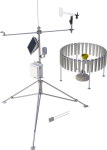O que nós fazemos
Campbell Scientific provides rugged, low-power measurement systems for many applications in snowy climates. Our systems measure snow depth, snow-water equivalent, air temperature, relative humidity, and wind speed and direction. This data is useful for displaying current weather conditions, identifying snow-making conditions, forecasting spring runoff and summer water availability, and modeling avalanche conditions.
Aprender maisVeja alguns exemplos impressionantes que nosso equipamento pode fazer nesta área
Customize a System
In addition to our standard systems available, many of the systems we provide are customized. Tell us what you need, and we’ll help you configure a system that meets your exact needs.
Componentes do Sistema
We offer a variety of products that can be used to create systems for Alpine Automated Weather Instrumentation. Many of the major components used to create these systems are listed below. Please let us know if we can help you configure a system.
Mais Detalhes sobre os Nossos Alpine Automated Weather Instrumentation Sistemas
Data loggers for unattended monitoring
Our monitoring stations are based around a programmable data logger (typically a CR1000X or CR3000) that measures the sensors, then stores and transmits the data. We designed our data loggers to provide a high level of station customization. They have programmable execution intervals, on-board instructions for commonly used sensors, and adequate input channels to accommodate many different sensor configurations.
CR1000X
If needed, channel capacity can be expanded using multiplexers, including a model designed specifically for thermocouples. Our data loggers interface directly to most sensors, eliminating external signal conditioning. Powerful on-board instruction sets allow unattended control decisions based on time or conditional events. For example, peripherals such as heaters or specialized sensors can be actuated based on temperature, wind speed, solar radiation, or some other measured parameter or event. These instruction sets contain programmed algorithms that process measurements and output results in the desired units of measure. Wind vector, wet bulb, histogram, and sample on maxima or minima are all standard to the data logger instruction sets.
CR3000
Measurement processing and data storage are programmable, but measurements are typically processed and stored at hourly and daily intervals (e.g., maxima, minima, averages). True averages can be calculated and stored by the data loggers. Conditional outputs can also be processed and stored. For example, data can be stored at faster intervals based on events such as increased wind speeds or subnormal temperatures.
Sensors
Almost any sensor can be measured by our data loggers, allowing stations to be customized for each site. Typical sensors used with our stations include, but are not limited to: relative humidity, solar radiation, wind speed and direction, air temperature, water temperature, soil temperature, precipitation, snow depth, barometric pressure, soil moisture, as well as strain gages, accelerometers, pressure transducers, GPS receivers, linear potentiometers, and many more.
Data Retrieval
We offer multiple communications options for data retrieval, allowing stations to meet exact needs. Telecommunication options include radio frequency, satellite (Argos, GOES), telephone (landline, voice-synthesized, cellular), short-haul, and multidrop. On-site options include storage module, laptop computer, and data logger keyboard/display. Robust error-checking and low-power use ensure your data arrives uncorrupted and as scheduled. We can even help you post your data to the Internet.
Software
Our Windows-based software simplifies data logger programming, data retrieval, and report generation. The data logger program can be modified at any time to accommodate different sensor configurations or new data processing requirements.
Estudos de Caso
Climate change is an important global issue that poses challenges to many facets of our......Leia mais
System integrator Hortus Srl installed a Campbell Scientific CS725 SWE (snow water equivalent) sensor in......Leia mais
Currently, the Andean tropical glaciers are in an accelerated process of retreat. These glaciers are......Leia mais
The water supplied by melting glaciers in the high Andes mountains is critical to many......Leia mais
Scientists and land-use managers have long recognized the importance of forest lands for their role......Leia mais
Campbell Scientific and Geo-Watersheds Scientific are research partners with the Cold Climate Housing Research Center......Leia mais
Intermountain Environmental was contracted to install two weather stations at Dodge Ridge Ski Resort. One......Leia mais
The SNOTEL data acquisition system measures the sensors with Campbell Scientific's data loggers, then transmits......Leia mais









